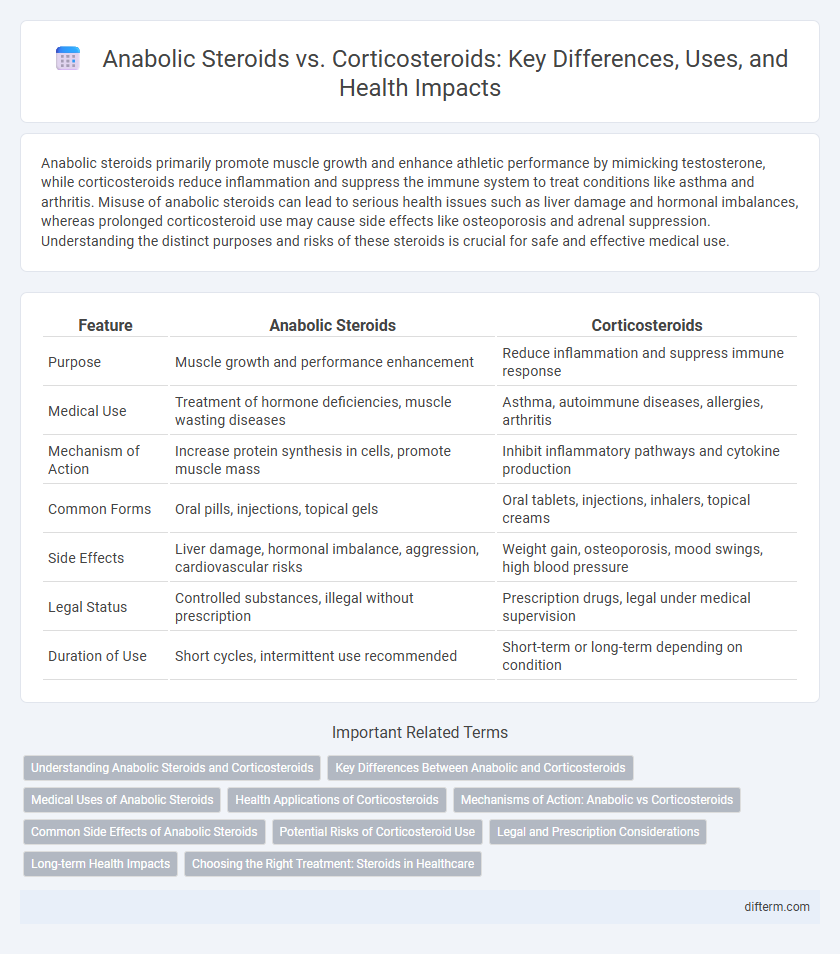Anabolic steroids primarily promote muscle growth and enhance athletic performance by mimicking testosterone, while corticosteroids reduce inflammation and suppress the immune system to treat conditions like asthma and arthritis. Misuse of anabolic steroids can lead to serious health issues such as liver damage and hormonal imbalances, whereas prolonged corticosteroid use may cause side effects like osteoporosis and adrenal suppression. Understanding the distinct purposes and risks of these steroids is crucial for safe and effective medical use.
Table of Comparison
| Feature | Anabolic Steroids | Corticosteroids |
|---|---|---|
| Purpose | Muscle growth and performance enhancement | Reduce inflammation and suppress immune response |
| Medical Use | Treatment of hormone deficiencies, muscle wasting diseases | Asthma, autoimmune diseases, allergies, arthritis |
| Mechanism of Action | Increase protein synthesis in cells, promote muscle mass | Inhibit inflammatory pathways and cytokine production |
| Common Forms | Oral pills, injections, topical gels | Oral tablets, injections, inhalers, topical creams |
| Side Effects | Liver damage, hormonal imbalance, aggression, cardiovascular risks | Weight gain, osteoporosis, mood swings, high blood pressure |
| Legal Status | Controlled substances, illegal without prescription | Prescription drugs, legal under medical supervision |
| Duration of Use | Short cycles, intermittent use recommended | Short-term or long-term depending on condition |
Understanding Anabolic Steroids and Corticosteroids
Anabolic steroids are synthetic variations of testosterone that promote muscle growth and enhance physical performance, commonly misused in bodybuilding and sports. Corticosteroids, derived from cortisol, are primarily used to reduce inflammation and suppress immune responses in conditions such as asthma, arthritis, and autoimmune diseases. Understanding the distinct physiological effects and medical uses of anabolic steroids versus corticosteroids is crucial for informed treatment and avoiding misuse.
Key Differences Between Anabolic and Corticosteroids
Anabolic steroids primarily promote muscle growth and enhance athletic performance by mimicking testosterone, while corticosteroids reduce inflammation and suppress immune responses to treat conditions like asthma and arthritis. Anabolic steroids are typically abused for bodybuilding, leading to side effects such as liver damage and hormonal imbalances, whereas corticosteroids have medical uses with risks including weakened immunity and osteoporosis when used long-term. Understanding their distinct mechanisms--anabolic steroids influencing anabolic processes and corticosteroids modulating catabolic and immune pathways--is crucial for safe and effective therapeutic applications.
Medical Uses of Anabolic Steroids
Anabolic steroids are primarily used in medical treatment to promote muscle growth in patients with wasting diseases such as cancer, AIDS, and severe burns. They help stimulate protein synthesis, increase nitrogen retention, and improve muscle mass and strength, aiding in recovery and rehabilitation. Unlike corticosteroids, which are used to reduce inflammation and suppress the immune system, anabolic steroids focus on anabolic processes to enhance tissue building and repair.
Health Applications of Corticosteroids
Corticosteroids are primarily used in health care to reduce inflammation and suppress immune responses in conditions such as asthma, rheumatoid arthritis, and lupus. Unlike anabolic steroids that promote muscle growth, corticosteroids target inflammatory processes, providing relief in allergic reactions, autoimmune diseases, and chronic inflammatory disorders. Their application includes topical, oral, and injectable forms to manage symptoms and improve patients' quality of life effectively.
Mechanisms of Action: Anabolic vs Corticosteroids
Anabolic steroids stimulate protein synthesis in muscle cells by binding to androgen receptors, promoting muscle growth and strength. Corticosteroids act by binding to glucocorticoid receptors, modulating gene expression to reduce inflammation and suppress immune responses. The contrasting mechanisms highlight anabolic steroids' role in tissue anabolism, while corticosteroids primarily regulate catabolic and anti-inflammatory processes.
Common Side Effects of Anabolic Steroids
Common side effects of anabolic steroids include liver damage, elevated blood pressure, acne, aggressive behavior, and hormonal imbalances such as testicular atrophy and gynecomastia in men. Users may also experience mood swings, increased risk of heart disease, and infertility. Unlike corticosteroids, which commonly cause immunosuppression and osteoporosis, anabolic steroids primarily affect muscle growth and endocrine system function.
Potential Risks of Corticosteroid Use
Corticosteroid use carries potential risks including increased susceptibility to infections, osteoporosis, and adrenal suppression. Long-term use may lead to weight gain, hypertension, and mood swings, impacting overall health. Careful medical supervision is essential to mitigate adverse effects and safely manage therapeutic benefits.
Legal and Prescription Considerations
Anabolic steroids are classified as controlled substances, requiring a prescription for legitimate medical use such as hormone replacement therapy, while their non-prescribed use is illegal and associated with significant legal penalties. Corticosteroids are widely prescribed for inflammatory and autoimmune conditions, available in various forms with regulated dosages, and are legal when used under medical supervision. Both require strict adherence to prescription guidelines to avoid health risks and legal consequences.
Long-term Health Impacts
Anabolic steroids, often used for muscle growth and athletic performance, can lead to long-term health complications such as cardiovascular disease, liver damage, and hormonal imbalances. Corticosteroids, primarily prescribed for inflammatory and autoimmune conditions, carry risks of osteoporosis, adrenal suppression, and increased susceptibility to infections with prolonged use. Both drug classes require careful medical supervision to mitigate serious chronic health effects.
Choosing the Right Treatment: Steroids in Healthcare
Anabolic steroids, synthetic variations of testosterone, are primarily used to promote muscle growth and enhance physical performance, while corticosteroids are anti-inflammatory agents prescribed to treat conditions like asthma, arthritis, and autoimmune diseases. Choosing the right steroid treatment depends on the underlying health condition, desired therapeutic effects, and potential side effects such as hormonal imbalances or immune suppression. Healthcare providers must carefully evaluate patient history and clinical needs to optimize steroid use for effective and safe outcomes.
Anabolic steroids vs corticosteroids Infographic

 difterm.com
difterm.com